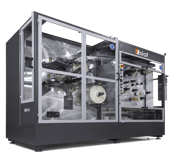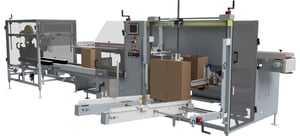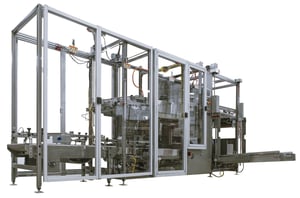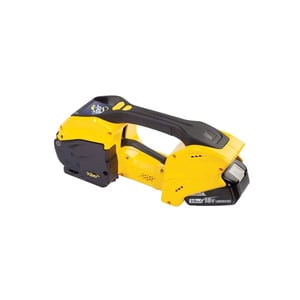For the past 30 years, Fred May, BSME, has helped businesses to automate their end-of-line packaging operations. But he’ll tell you there are times when less is more.
“There are those projects when a customer wants full automation, but then you learn they do five changeovers a day and run 25 different SKUs,” says May, regional senior sales manager at Combi. “We could put together that system, but it’s going to cost too much for them to get the ROI out of it.”
May has a well-rounded perspective. Before his current role, he worked at Combi as an engineer, engineering manager, system integrator and project manager. He’s seen every type of business and considered projects from every angle.
“We talk a lot about robotics, and for good reason,” May says. “Industrial robots are powerful tools. They’re flexible and durable and there are so many ways to use them.”
But there’s a catch. They can only do what they’re programmed to do, and if you want a robot arm to handle all your SKUs and all your carton configurations, every one of those routines has to be written and loaded into the robot.
End-of-line packaging automation: Volume vs. variety
For businesses with short runs or frequently changing product mixes, the programming can be a deal-breaker.
“Sometimes you have to tell them we can provide a different solution with less automation for half the price and it will be a better fit,” May says. “Instead of going from five people on the production line to just one, they might still have two people working the line, but they’ll get the payback much faster without breaking the bank.”
An example:
“We offer quick changeover packages on our case erectors that let you change from one size case to another,” May says. “But if you have a dozen box sizes and you only make 25 or 50 per day of each, you’ll still spend more time changing over than actually making boxes. You either need to consolidate the list of box sizes, or you need to keep putting them together by hand.”
So the variety of products and types of packaging are important factors in evaluating how much automation is appropriate.
Packaging laborers vs. packaging equipment specialists
Another important factor is staffing. Today, businesses often look to automate as a way of reducing labor—perhaps to save money, but just as likely because they can’t find people to fill open positions.
“I’ve seen companies that are running three shifts with all manual labor. They get excited about automating. But automated equipment requires skilled maintenance people to keep the line up and running—and those jobs aren’t exactly easy to fill either,” May says.
Even large companies can make the mistake of deploying robotics at a distribution center before realizing that none of their skilled technicians are stationed there. Suddenly, the facility becomes a maintenance headache, expediting parts and flying technicians in from other locations to fix emergencies.
Time vs. space for end-of-line packaging equipment installation
Another consideration is whether the facility itself can accommodate the desired level of automation.
May recently talked a customer out of adding an extended power magazine to the automated case erector they were preparing to install.
The option would have saved some time reloading box blanks, according to May. But the line was only handling 3-to-4 cases per minute—less than a third of its potential throughput, and not fast enough to justify the extra magazine capacity.
“I looked at the space they had; the thing was going to stick out in the aisle. It wasn’t going to make much difference in productivity but was going to be a constant safety issue,” he says.
Properly scaled packaging automation solutions
So what’s the answer for an operation whose key performance indicators point to a need for more automation—but whose financials, staffing or floor space say otherwise?
“Often, there are other places in the production where automation can help,” May says.
If a traditional case packer – or even a semi-automated hand-packing station – is a better fit than a robot, there may be room for improvement at the palletizing station. For example, May points to Combi’s EZ Pal portable robotic palletizing cell, which is designed to be moved by forklift from one packaging line to another.
“Rather than a big conveyor system that brings product from the packaging lines to palletizing, you can do the palletizing at the end of each packaging line,” he says. “It saves on floor space, it’s less equipment to manage, it increases flexibility and still provides the overall improvement in productivity.”
In operations where precision and quality are more important than speed, a single robot arm might alternate between packing cases and assembling pallets. “You can have it packing cases, and then a conveyor brings them around again for palletizing,” May says. “It’s a unique solution that Combi can offer because of the way we approach our business. We’re not just a case erector company or a packing company; we handle the whole job of getting packaged products ready to ship. We can automate every piece of it, but the art of what we do is in designing a solution that balances all of the operating and financial requirements.
“One thing that resonates with my customers is the personal touch; we’re flexible enough to customize our machinery to meet their requirements. It’s heavy duty; designed to run 2-3 shift operations. So it’s prepared for abuse.”
Do you have a workflow challenge in your end-of-line packaging operation? Contact Combi Packaging Systems for the broadest range of possible solutions.

.png?width=172&name=End%20of%20Year%20Sale%20Equip%20Drop%20Down%20(172%20x%20157%20px).png)






.png?width=161&name=ProWrap%20(1).png)


